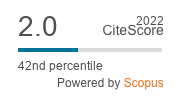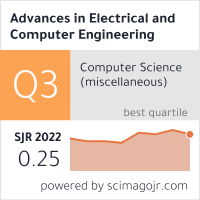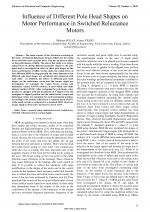| 3/2020 - 9 |
Influence of Different Pole Head Shapes on Motor Performance in Switched Reluctance MotorsPOLAT, M. |
| View the paper record and citations in |
| Click to see author's profile in |
| Download PDF |
Author keywords
acoustic noise, inductance curve, radial force, switched reluctance motor, torque ripple
References keywords
reluctance(20), switched(17), motors(10), applications(10), design(9), torque(8), motor(8), industry(8), analysis(6), magnet(5)
Blue keywords are present in both the references section and the paper title.
About this article
Date of Publication: 2020-08-31
Volume 20, Issue 3, Year 2020, On page(s): 75 - 82
ISSN: 1582-7445, e-ISSN: 1844-7600
Digital Object Identifier: 10.4316/AECE.2020.03009
Web of Science Accession Number: 000564453800009
SCOPUS ID: 85090342696
Abstract
The main reasons of the vibrations occurring in the stator of Switched Reluctance Motors (SRM) are the radial forces and they cause acoustic noise. This has an adverse effect on the performance of SRM. The aim of this study is to reduce radial forces by giving different geometric shapes to the pole heads and to investigate the effect of these pole shapes on the motor performance of SRM. In this study, the radial forces of four different SRMs having generally the same dimensions but different pole head shapes are calculated and compared with each other. In addition, the effects of different pole head shapes on the inductance curve and the torque ripple are investigated. To calculate the radial forces, torque and inductance values, ANSYS software is used which uses finite element method (FEM). After reshaping the pole heads, rotor position is changed with the increments of 1 degree from the unaligned to aligned position and the radial forces, torque and inductance values are calculated for each incremental position. According to the results, radial force is reduced about 19.03% at the rated current as compared to a standard SRM. However, torque ripple is observed to increase by about 3.29%. |
| References | | | Cited By «-- Click to see who has cited this paper |
| [1] E. El-Kharashi, H. Hassanien, "Reconstruction of the switched reluctance motor stator," Journal of Electrical Engineering, vol. 63, no. 1, pp. 3-12, 2012. [CrossRef] [Web of Science Times Cited 5] [2] A. Yildiz, M. Polat, "Investigation of the effect of stator and rotor pole ratios on torque and efficiency in Inverted Switched Reluctance Motor," Journal of Engineering and Technology, vol. 3, no. 1, pp. 12-24, 2019. [3] E. K. Beser, S. Camur, B. Arifoglu, E. Beser, "Design and Analysis of an Axially Laminated Reluctance Motor for Variable-Speed Applications," Advances in Electrical and Computer Engineering, vol.13, no.1, pp.75-80, 2013. [CrossRef] [Full Text] [Web of Science Times Cited 8] [4] K. Wrobel, K. Tomczewski, "Effect of Objective Function Formulation on Static and Operating Parameters of a Switched Reluctance Motor After Optimization of Magnetic Circuit Shape," Advances in Electrical and Computer Engineering, vol.18, no.3, pp.23-28, 2018. [CrossRef] [Full Text] [Web of Science Times Cited 1] [5] A. Yildiz, M. Polat, M. T. Ozdemir, "Design Optimization of Inverted Switched Reluctance Motor using Ant Colony Optimization Algorithm," 2018 International Conference on Artificial Intelligence and Data Processing (IDAP), Malatya, Turkey, 2018. [CrossRef] [6] D. E. Cameron, J. H. Lang, S. D. Umans, "The origin of acoustic noise in variable-reluctance motors," Conference Record of the IEEE Industry Applications Society Annual Meeting, San Diego, USA, 01-05 October 1989. [CrossRef] [Web of Science Times Cited 19] [7] D. E. Cameron, J. H. Lang, S. D. Umans, "The origin of acoustic noise in variable-reluctance motors," IEEE Transaction on Industry Applications, vol. 28, no. 6, pp. 1250-1255, 1992. [CrossRef] [Web of Science Times Cited 294] [8] Y. Tang, "Characterization, numerical analysis, and design of switched reluctance motors," IEEE Transactions on Industry Applications, vol. 33, no.6, pp. 1544-1552, 1997. [CrossRef] [Web of Science Times Cited 35] [9] X. Cao, Q. Liu, H. Zhou, Z. Deng, "Direct control of torque and levitation force for dual-winding bearingless switched reluctance motor," Electric Power Systems Research, vol. 145, pp. 214-222, 2017. [CrossRef] [Web of Science Times Cited 19] [10] Y. Ohdachi, Y. Kawase, Y. Miura, Y. Hayashi, "Optimum design of switched reluctance motors using dynamic finite element analysis," IEEE Transaction on Magnetics, vol. 33, no. 2 pp. 2033-2036, 1997. [CrossRef] [Web of Science Times Cited 31] [11] K. Koibuchi, T. Onho, K. Sawa, "A basic study for optimal design of switched reluctance motor by finite element method," IEEE Transaction on Magnetics, vol. 33, no. 2 pp. 2077-2080, 1997. [CrossRef] [Web of Science Times Cited 22] [12] P. Pillay, W. Cai, "An investigation into vibration in switched reluctance motors," IEEE Transactions on Industry Applications, vol. 35, no. 3, pp. 589- 596 1999. [CrossRef] [Web of Science Times Cited 83] [13] M. Sanada, S. Morimoto, Y. Takeda, N. Matsui, "Novel rotor pole design of switched reluctance motors to reduce the acoustic noise," Conference Record of the 2000 IEEE Industry Applications Conference, Thirty-Fifth IAS Annual Meeting and World Conference on Industrial Applications of Electrical Energy, Rome, Italy, 08-12 October 2000. [CrossRef] [14] M. N. Anwar, O. Husain, "Radial force calculation and acoustic noise prediction in switched reluctance machines," IEEE Transactions on Industry Applications, vol. 36, no. 6, pp. 589- 1597, 2000. [CrossRef] [15] T. J. E. Miller, "Optimal design of switched reluctance motors," IEEE Transaction on Industrial Electronics, vol. 49, no. 1, pp. 15- 27, 2002. [CrossRef] [Web of Science Times Cited 201] [16] R. Brambilla, F. Grilli, L. Martini, M. Bocchi, G. Angeli, "A finite-element method framework for modeling rotating machines with superconducting windings," IEEE Transactions on Applied Superconductivity, vol. 28, no. 5, pp. 1-11, 2018. [CrossRef] [Web of Science Times Cited 61] [17] A. Jabbari, "Exact analytical modeling of magnetic vector potential in surface inset permanent magnet DC machines considering magnet segmentation," Journal of Electrical Engineering, vol. 69, no. 1, pp. 39-45, 2018. [CrossRef] [Web of Science Times Cited 7] [18] S. Hartmann, "A remark on the application of the Newton-Raphson method in non-linear finite element analysis," Computational Mechanics, vol. 36, no. 2, pp. 100-116, 2005. [CrossRef] [Web of Science Times Cited 62] [19] M. Moallem, C. M. Ong, L.E. Unnewehr, "Effect of rotor profiles on the torque of a switched reluctance motor," IEEE Transactions on Industry Applications, vol. 28, no. 2, pp. 364-369, 1992. [CrossRef] [Web of Science Times Cited 41] [20] D. Zarko, D. Ban, and T. A. Lipo, "Analytical solution for cogging torque in surface permanent-magnet motors using conformal mapping", IEEE Transactions on Magnetics, vol. 44, no.1, pp. 52-65, 2008. [CrossRef] [Web of Science Times Cited 232] [21] M. Moallem, C. M. Ong, "Predicting the torque of a switched reluctance machine from its finite element field solution," IEEE Transactions on Energy Conversion, vol. 5, no. 4, pp. 733-739, 1990. [CrossRef] [Web of Science Times Cited 42] [22] M. Abbasian, M. Moallem, B. Fahimi, "Double-stator switched reluctance machines (DSSRM): Fundamentals and magnetic force analysis," IEEE Transactions on Energy Conversion vol. 25, no. 3, pp. 589-597, 2010. [CrossRef] [Web of Science Times Cited 136] [23] C. Lee, R. Krishnan, "New designs of a two-phase E-core switched reluctance machine by optimizing the magnetic structure for a specific application: Concept, design, and analysis," IEEE Transactions on Industry Applications, vol. 45, no. 5, pp. 1804-1814, 2009. [CrossRef] [Web of Science Times Cited 83] [24] W. Zhu, B. Fahimi, S. Pekarek, "A field reconstruction method for optimal excitation of permanent magnet synchronous machines," IEEE Transactions on Energy Conversion, vol. 21, no. 2, pp. 305-313, 2006. [CrossRef] [Web of Science Times Cited 94] [25] M. Galip, Y. Ozoglu, E. Mese, "An approach to torque ripple reduction in fully pitched switched reluctance motors by pole tip shaping," 11th IEEE Mediterranean Electrotechnical Conference, Cairo, Egypt, 07-09 May 2002. [CrossRef] [Web of Science Times Cited 3] [26] J. H. Lee, E. W. Lee, J. H. Kim, D. J. Lee, "Design of the single phase SRM considering the torque ripple," 2005 International Conference on Power Electronics and Drives Systems, Kuala Lumpur, Malaysia, 2005. [CrossRef] [27] Y. Fan, K. T. Chau, "Torque ripple minimization of four-phase doubly salient permanent magnet motors using two-phase operation," Electric Power Components and Systems, vol. 28, no.4, pp. 401-415,2006. [CrossRef] [Web of Science Times Cited 2] Web of Science® Citations for all references: 1,481 TCR SCOPUS® Citations for all references: 0 Web of Science® Average Citations per reference: 53 ACR SCOPUS® Average Citations per reference: 0 TCR = Total Citations for References / ACR = Average Citations per Reference We introduced in 2010 - for the first time in scientific publishing, the term "References Weight", as a quantitative indication of the quality ... Read more Citations for references updated on 2024-04-16 01:16 in 147 seconds. Note1: Web of Science® is a registered trademark of Clarivate Analytics. Note2: SCOPUS® is a registered trademark of Elsevier B.V. Disclaimer: All queries to the respective databases were made by using the DOI record of every reference (where available). Due to technical problems beyond our control, the information is not always accurate. Please use the CrossRef link to visit the respective publisher site. |
Faculty of Electrical Engineering and Computer Science
Stefan cel Mare University of Suceava, Romania
All rights reserved: Advances in Electrical and Computer Engineering is a registered trademark of the Stefan cel Mare University of Suceava. No part of this publication may be reproduced, stored in a retrieval system, photocopied, recorded or archived, without the written permission from the Editor. When authors submit their papers for publication, they agree that the copyright for their article be transferred to the Faculty of Electrical Engineering and Computer Science, Stefan cel Mare University of Suceava, Romania, if and only if the articles are accepted for publication. The copyright covers the exclusive rights to reproduce and distribute the article, including reprints and translations.
Permission for other use: The copyright owner's consent does not extend to copying for general distribution, for promotion, for creating new works, or for resale. Specific written permission must be obtained from the Editor for such copying. Direct linking to files hosted on this website is strictly prohibited.
Disclaimer: Whilst every effort is made by the publishers and editorial board to see that no inaccurate or misleading data, opinions or statements appear in this journal, they wish to make it clear that all information and opinions formulated in the articles, as well as linguistic accuracy, are the sole responsibility of the author.





